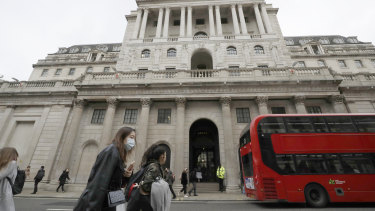While there’s been a lot of focus on the language the Bank for International Settlements used to describe cryptocurrencies and stablecoins in a pre-released chapter of its annual report last week the more substantial take away from its paper lies not in that language but in the overall tone of its discussion of central bank-issued digital currencies.
The major central banks have generally adopted an ultra-cautious and quite leisurely approach to their investigations of the potential of central bank digital currencies (CBDCs) and have been dismissive of the implications of cryptocurrencies and other private-sector digital currency initiatives.
A radical redesign of an ever-evolving but centuries-old monetary system – the first central bank was created in the 17th century – is looming larger and closer as the external pressures for change from privately sponsored and issued digital currencies intensify.Credit:AP
The BIS paper underscores how rapidly that stance is evolving as the Basel institution, sometimes dubbed the central bank for central bankers, takes stock of the acceleration in the real-world development of digital currencies.
While it remains dismissive of their potential threat to conventional monetary systems – cryptocurrencies are purely speculative assets used for nefarious purposes and stablecoins are just “an appendage to the conventional monetary system and not a game-changer” – the BIS has shifted from analyst to promoter of CBDCs.
Part of the motivation for that change is that the BIS and the key central banks underestimated the pace and extent to which cryptocurrencies would become mainstream; the determination of the mega-tech companies to gate-crash the monetary system and the speed at which China would move to develop on introduce its own central bank-issued digital currency.
China is already running a domestic pilot project for the issuance of a digital yuan while also exploring the infrastructure requirements needed to support cross-border usage of a digital currency.
Facebook, frustrated at the lack of progress in its attempt to obtain Swiss regulatory approval for it planned stablecoin – initially called Libra but re-badged as Diem – has abandoned that effort, shifted its operational headquarters to the US and changed the original proposal of a digital token backed by a basket of currencies to one backed by US dollars.
The Facebook-led consortium backing Diem plans to launch its digital currency, first unveiled in 2019, later this year.
A year ago bitcoin was trading at less than $US10,000. It peaked last month at $US63,000 before crashing below $US35,000. That still gives it a market capitalisation of about $US650 billion. The overall cryptocurrency market is worth about $US1.4 trillion, down from a peak of $US2.5 trillion last month.
While that volatility tends to underwrite the BIS dismissal of cryptocurrencies, and bitcoin in particular, as mere vehicles for speculation – assets so volatile can never be widely-accepted and legitimate media of exchange – they, and privately-issued stablecoins, do represent a large and growing unregulated sliver of the monetary system.
They can be used for money-laundering, tax evasion, criminal and terrorist transactions and, if not regulated and countered, could eventually have implications for the liquidity and stability of the global financial system.
While giving a government agency insight into individuals’ daily financial transactions might be attractive to an authoritarian regime, it wouldn’t be tolerated in most developed economies.
The newfound seriousness with which previously-complacent central bankers are taking those threats was reinforced earlier this year when the UK announced it had created a taskforce to explore the potential of a Bank of England-issued digital currency – a “Britcoin” – to protect the pound against cryptocurrencies and improve the UK payment system.
The BIS appears particularly concerned about the potential for Big Tech to leverage their customer data and network effects to drive acceptance of their cryptocurrencies and entrench their market power.
It cites China’s experience (which led to a major crackdown on its tech sector and helped fast-track the development of the digital yuan), where two big tech companies – Tencent and Alipay – account for 94 per cent of the mobile payment market.
the UK announced it had created a taskforce to explore the potential of a Bank of England-issued digital currency to protect the pound against cryptocurrencies and improve the UK payment system.Credit:AP
The key issues central bankers have been pondering for nearly a decade as they have looked at CBDCs are their potential to generate payment system efficiencies and to increase competition for the incumbent institutions against their implications for the security and stability of monetary system and for the privacy of end-users.
Having recognised that if they don’t respond to the emergence of digital currencies with their own versions and that a critical public interest issue is who will own and have access to customer data – big tech, central banks or regulated intermediaries – the BIS seems to have moved past the question of whether there will be CBDCs to one of the detail of design.
The detail is vital. There are two broad options central banks can follow in creating a digital version of their currency. They can make it available at a wholesale level – issuing it to banks and other authorised institutions – with the existing institutions retaining ownership of the customers and their data.
Another, more radical, option would be to create retail CBDCs, effectively creating a digital version of physical currencies, and issuing them directly to the public.
Retail CBDCs would remove credit risk from the financial system, given they are a direct claim on the central bank and would probably increase competition and innovation but could create existential issues for existing institutions, like banks, that are reliant on customer deposits and generate massive challenges for the central bank in trying to administer individual accounts.
There are also question of data governance and privacy that need to be resolved before a CBDC is workable, whether it’s a wholesale, retail or hybrid version.
While giving a government agency insight into individuals’ daily financial transactions might be attractive to an authoritarian regime, it wouldn’t be tolerated in most developed economies.
The privacy and financial stability issues will shape the design outcomes and probably result in wholesale CBDCs that use existing financial system infrastructure to manage customers and their data, manage the credit assessments and risk-management and comply with anti-money-laundering and other regulatory requirements.
The BIS favours account-based, identity-linked CBDCs with protections for privacy and security, although that would require a lot of flow-on decisions about the role of banks and other intermediaries and the vexatious core issue of access to the data.
By moving on from the leisurely “should we?” discussions of the past to an acceptance of the inevitability of central bank-issued digital currencies the BIS is helping to bring the future of money and the future financial system closer and dragging its generally reluctant members along with it.
A radical redesign of an ever-evolving but centuries-old monetary system – the first central bank was created in the 17th century – is looming larger and closer as the external pressures for change from privately sponsored and issued digital currencies intensify.
The Market Recap newsletter is a wrap of the day’s trading. Get it each weekday afternoon.
Most Viewed in Business
From our partners
Source: Read Full Article


